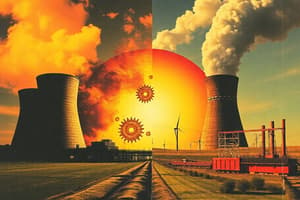Podcast
Questions and Answers
What distinguishes fusion from fission in terms of energy release?
What distinguishes fusion from fission in terms of energy release?
- Fusion occurs at lower temperatures than fission.
- Fusion releases more energy per reaction than fission. (correct)
- Fusion releases less energy per reaction than fission.
- Fusion can produce long-lived radioactive waste.
Which of the following isotopes is primarily involved in fission reactions?
Which of the following isotopes is primarily involved in fission reactions?
- Deuterium
- Tritium
- Hydrogen-2
- Uranium-235 (correct)
What is a significant safety advantage of fusion over fission?
What is a significant safety advantage of fusion over fission?
- Fusion generates long-lived radioactive waste.
- Fusion reactions occur at ambient temperature.
- Fusion does not require any external conditions.
- Fusion poses a lower risk of accidents compared to fission. (correct)
What is a critical condition for achieving nuclear fusion?
What is a critical condition for achieving nuclear fusion?
What area of research focuses on making nuclear reactions sustainable?
What area of research focuses on making nuclear reactions sustainable?
What is the main outcome of the fusion process?
What is the main outcome of the fusion process?
Which type of fusion is primarily responsible for energy production in stars?
Which type of fusion is primarily responsible for energy production in stars?
What is a significant challenge in achieving controlled fusion on Earth?
What is a significant challenge in achieving controlled fusion on Earth?
How is inertial confinement fusion primarily achieved?
How is inertial confinement fusion primarily achieved?
Which project aims to make fusion a practical energy source through international collaboration?
Which project aims to make fusion a practical energy source through international collaboration?
Flashcards are hidden until you start studying
Study Notes
Overall Concept
-
Definitions:
- Fusion: The process where two light atomic nuclei combine to form a heavier nucleus, releasing energy.
- Fission: The process where a heavy atomic nucleus splits into two or more lighter nuclei, along with the release of energy.
-
Energy Release:
- Fusion releases more energy per reaction than fission.
- Both processes release energy due to mass-to-energy conversion, as described by Einstein's equation (E=mc^2).
-
Common Reactions:
- Fusion: Occurs in stars, including the Sun, primarily involving hydrogen isotopes (e.g., deuterium and tritium).
- Fission: Commonly occurs in nuclear reactors and atomic bombs, typically involving isotopes like Uranium-235 or Plutonium-239.
-
Conditions Required:
- Fusion: Requires extremely high temperatures and pressures to overcome electrostatic forces between positive nuclei (e.g., millions of degrees Celsius).
- Fission: Can occur at relatively lower temperatures; initiated by absorbing a neutron.
-
Applications:
- Fusion: Potential for clean energy through controlled nuclear fusion (e.g., ITER project); currently largely experimental.
- Fission: Widely used in nuclear power plants for electricity generation and in nuclear weapons.
-
Safety and Waste:
- Fusion: Produces minimal radioactive waste and poses a lower risk of accidents compared to fission.
- Fission: Generates long-lived radioactive waste and poses risks of accidents (e.g., meltdown).
-
Current Research:
- Fusion research focuses on achieving sustainable reactions (e.g., magnetic confinement, inertial confinement).
- Fission research includes improving reactor safety, waste management, and developing advanced reactor designs (e.g., small modular reactors).
Definitions
- Fusion combines two light atomic nuclei into a heavier nucleus, releasing energy.
- Fission splits a heavy atomic nucleus into lighter nuclei, also releasing energy.
Energy Release
- Fusion releases significantly more energy per reaction than fission.
- Both processes convert mass to energy, guided by Einstein's equation (E=mc^2).
Common Reactions
- Fusion primarily occurs in stars, such as the Sun, mainly involving hydrogen isotopes like deuterium and tritium.
- Fission is commonly used in nuclear reactors and atomic bombs, involving isotopes like Uranium-235 and Plutonium-239.
Conditions Required
- Fusion requires extreme temperatures and pressures (millions of degrees Celsius) to overcome the electrostatic repulsion between positive nuclei.
- Fission can occur at lower temperatures and is initiated by absorbing a neutron.
Applications
- Fusion has potential as a clean energy source through controlled nuclear reactions, exemplified by projects like ITER, but remains largely experimental.
- Fission is extensively used for generating electricity in nuclear power plants and is also utilized in nuclear weapons.
Safety and Waste
- Fusion produces minimal radioactive waste and carries a lower risk of catastrophic accidents compared to fission.
- Fission generates long-lived radioactive waste and carries risks of significant accidents, including reactor meltdowns.
Current Research
- Fusion research aims to achieve sustainable nuclear reactions, focusing on techniques such as magnetic and inertial confinement.
- Fission research seeks to enhance reactor safety, improve waste management, and develop advanced reactor designs like small modular reactors.
Overall Concept of Fusion
- Definition: Fusion combines lighter atomic nuclei, forming a heavier nucleus and releasing energy.
- Basic Principle: Overcoming electrostatic repulsion between positively charged nuclei is essential for fusion.
- Conditions: Requires extreme temperatures and pressures, typically present in stellar environments like stars.
- Energy Release: Governed by Einstein’s equation, E=mc², converting mass into energy during fusion.
- Types of Fusion:
- Stellar Fusion: Predominantly occurs in stars, transforming hydrogen into helium.
- Inertial Confinement Fusion: Compresses and heats a fuel target using lasers or other methods to achieve fusion.
- Magnetic Confinement Fusion: Utilizes magnetic fields to contain plasma at elevated temperatures, exemplified by tokamaks.
- Importance:
- Fundamental energy source for stars, including the Sun.
- Holds potential as a clean energy source on Earth via controlled fusion reactions.
- Challenges: Achieving requisite fusion conditions on Earth remains technically challenging; many current experiments consume more energy than they produce.
- Current Research:
- Initiatives like ITER are exploring fusion as a practical energy source.
- Investigating innovative methods such as stellarators and advanced magnetic confinement techniques.
Studying That Suits You
Use AI to generate personalized quizzes and flashcards to suit your learning preferences.




